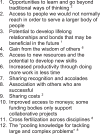Interprofessional collaboration in research, education, and clinical practice: working together for a better future
- PMID: 25594446
- PMCID: PMC4360764
- DOI: 10.7899/JCE-14-36
Interprofessional collaboration in research, education, and clinical practice: working together for a better future
Abstract
Interprofessional collaboration occurs when 2 or more professions work together to achieve common goals and is often used as a means for solving a variety of problems and complex issues. The benefits of collaboration allow participants to achieve together more than they can individually, serve larger groups of people, and grow on individual and organizational levels. This editorial provides an overview of interprofessional collaboration in the areas of clinical practice, education, and research; discusses barriers to collaboration; and suggests potential means to overcome them.
Keywords: Collaboration; Relations, Interprofessional; Role, Professional; Trust.
Figures



References
-
- Hansen MT. Collaboration: How Leaders Avoid the Traps, Create Unity, and Reap Big Results. Boston, MA: Harvard Business Press; 2009. xi, 231.
-
- Vangen S, Huxham C. Nurturing collaborative relations: building trust in interorganizational collaboration. J Appl Behav Sci. 2003;39:5–31.
-
- Kumar K, vanDissel HG. Sustainable collaboration: managing conflict in interorganizational systems. Manag Inf Syst Q. 1996;20(3):279–300.
-
- D'Amour D, Ferrada-Videla M. San Martin Rodriguez L, Beaulieu MD. The conceptual basis for interprofessional collaboration: core concepts and theoretical frameworks. J Interprof Care. 2005;((suppl 1)):116–131. - PubMed
-
- Mattessich PW, Monsey BR. 53 St. Paul, MN: Amherst H. Wilder Foundation; 1992. Collaboration—What Makes It Work: A Review of Research Literature on Factors Influencing Successful Collaboration. Wilder Research Center.
LinkOut - more resources
Full Text Sources
